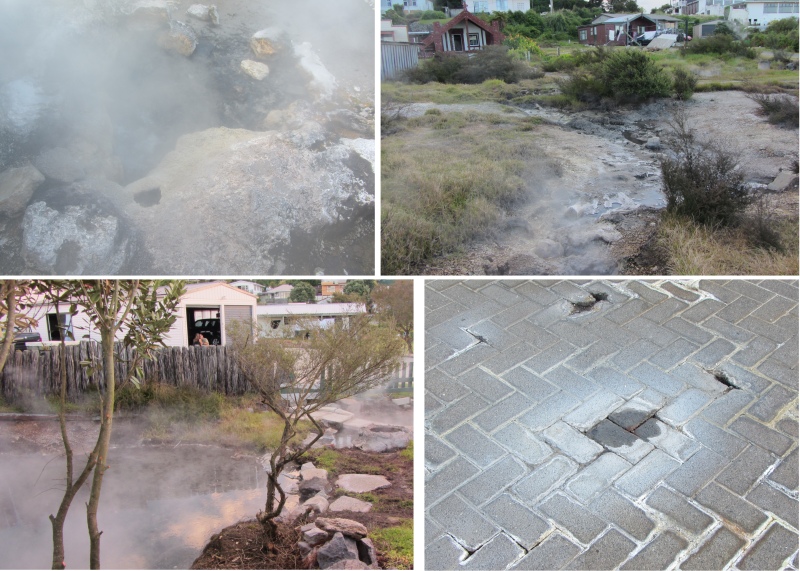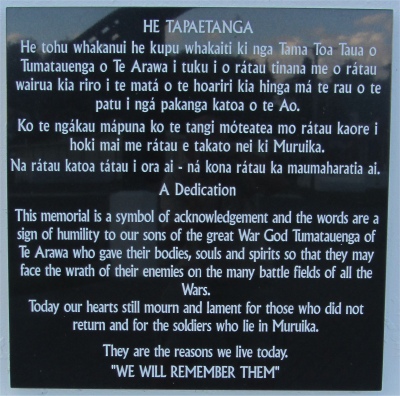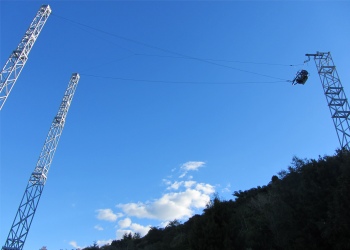We talked at length about travel, his love of British history, his business, and the quaint expressions used in Britain, such as "the coast is clear", all of which he knew where they were derived from. He just adored the language. Over the course of hours, we talked and he managed to make a few sales too.

Ohinemutu Roadside, Garden and Block Paving Thermal Features
|
The poor fellow had managed to screw up on his computer, and some folders containing photos had gone missing. I managed to retrieve some, but sadly others had been overwritten. I reprimanded him for not having backups, then explained what backups were. He's not the first one.
4.5 hours and a couple of coffees later, we said our farewells and I headed off to Rotorua. It was a pleasant drive with giant molehill landscapes similar to those I had seen when I made the drive south to Te Kuiti quite a while back. I knew I was approaching Rotorua when I smelt the whiff of hydrogen sulphide in the air.
Located on a volcanic plateau which covers much of the Central North Island, Rotorua sits in the middle of the Taupo Volcanic Zone, which is named after Lake Taupo, the largest volcano in the area. There are four major volcanic calderas, which now contain lakes, and several more recognisable volcanoes in the surrounding area. It is this geologically active zone that produces the heat that is needed to drive all the geothermal activity. Geysers, kaleidoscopic hot mud pools, steaming craters and terraces of encrusted silicates are testament to the incredible earthen forces on display in this diversely beautiful location.

One of the Many Marae in Ohinemutu
|
The shores of clear, trout-filled Lake Rotorua and Whakawerawera were first settled by Maori in the 14th century, and to this day the area still contains a prominent 35% by population Maori community, and as such, is an ideal place to sample a hangi, a traditional feast cooked in an earth oven, followed by a Maori concert. When European settlement began, the population rapidly expanded, drawn by the aesthetic and therapeutic properties of the thermal springs, and hence the birth of modern Rotorua.
The region was the birthplace of New Zealand tourism in the 1800s, when people flocked here from around the world to see the amazing Pink and White Terraces - vast, naturally formed silica terraces that cascaded into a volcanic lake. The Te Arawa people were their local guides. The terraces were destroyed in the 1886 Mount Tarawera eruption, but Rotorua's fame as a fascinating travel destination continued to grow.
When George Bernard Shaw first visited Rotorua in 1934, he declared: "I was pleased to get so close to Hades and be able to return." Rotorua, aka "Sulphur City", is one of the most popular visitor attractions in the country. Sitting squarely on top of the Taupo Volcanic Zone, it is New Zealand's answer to Yellowstone Park.

Memorial to the War Dead
|
Nestled beside the cerulean blue Lake Rotorua, the town sprawls on its southern shores. Rotorua, voted New Zealand's most beautiful city six times, is home to one of the most unique tourism sites in the world. Aside from the breath-taking scenery of this volcanic-shaped wonderland, the 16 beautiful lakes in the region and the lush green of the abundant native flora, Rotorua is a geothermal paradise and the cultural heartland. Its half-timbered, mock-Tudor buildings recalled its development as a European-style health spa at the beginning of the 20th century.
After picking up a campsite, I drove down to the Skyline Skyrides on Mount Ngongotaha, and took a gondola up in order to get a view across the town, lake and beyond. When I alighted at the top, I found a small crowd gathered watching two frightened teenagers on a sky swing. The swing was suspended between two tall towers, and the seat in which they were cowering had been winched up to the top of a third tall tower. The object of the exercise was that once winched up, the occupants, full of bravado, would pull a cable that would release them to a death defying drop and swing. Unfortunately, the two occupants wanted to defy death by chickening out on the cable pulling exercise.
The friends/relatives of the two unfortunate souls were screaming a mixture of encouragement and embarrassed abuse at them, and the crowd were also shouting up to them, "Just pull the cable," or words to that effect. Apparently there was no way that the cable could be pulled from the control station.
"How long have they been up there - since breakfast time?" I joked with the old fellow standing next to me. "No idea, but we've been here for at least half an hour," he laughed. "How are they going to feel when they do the walk of shame past us?" his wife chirped in. "Do we applaud or give them a slow hand clap?" I jested, which caused a titter of mirth.
"Have you got the time, mate?" asked the old chap after a while. "Yes, it's 18:15," I obliged. "Hey, Mary," he shouted across to his wife, "the cricket starts at 7 o'clock. We better get a move on." His priorities in life were sorted.
Eventually, one of the swing operators climbed to the base of the third tower with some kit, and slowly lowered them down halfway, and then stopped. Life was too short to watch the end of the episode, and we all drifted off to fulfil what we had intended to do on the mountain side. When I returned past the swing after taking in the views, the swing was down and the place deserted. The occupants would have paid $50 each for their embarrassment.

Maori War Graves by St Faith's Anglican Church
|
Now I had a better lay of the land, I drove down to near the lakeside, and ventured out on a short walk through a residential area in Ohinemutu, a ramshackle and mainly Maori village with its own unique charm, to the lake. That walk was extraordinary. I instantly felt like I had entered another world, where hot steam escapes from cracks in the road and common land, and back gardens come with their own natural mineral hot pool and the pungent aroma of sulphur exotically permeates the air. Everywhere I looked there were fumaroles and countless bubbling pools and streams of scalding hot water.
Some residents had made primitive heat exchangers and inserted them into the pool or stream in their garden, thus giving them limitless boiling water. Others had tin shacks erected which housed their own private hot pool spa. Maori even used the pools for cooking in. It was indeed an extraordinary sight. By now I had got used to the extraordinary smell.
The pavements in this lakeside setting emanated heat. I stooped down to touch their surface; the pavements were not warm, they were hot. Maori often walk about in bare feet, but I can't imagine many walking around this environment barefooted.
And what was even more peculiar, having spent a while walking around the Craters of the Moon site yesterday, where visitors were kept well away from fumaroles and pools by fences, most of these potentially lethal Rotoruan geothermal features were unfenced. It must be a nightmare for parents.
On a promontory stood St Faith's Anglican Church with a collection of war graves behind it plus a memorial. As opposed to the white crosses so commonly found in European war graves, the Maori graves here were marked by white, stone caskets of giant proportions.
As stated earlier, the area was heavily populated by Maori, and many marae were to be found near the lake.
I later walked into the main tourist thoroughfare, a collection of cafes, restaurants, bars, shops etc. However, the instant charm for me was that first short walk to the lake, being seemingly so close to raw nature. Unforgettable.






